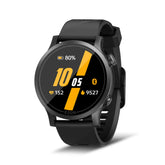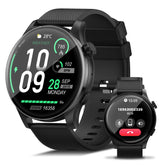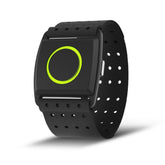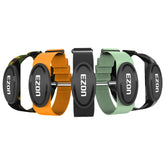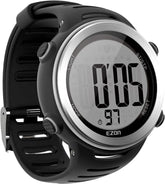The Definitive Running Guide: Unlock Your Peak Performance with Heartbeat and Step Tracking
Running is more than lacing up and hitting the pavement—it’s a science of energy, rhythm, and self-awareness. This running guide demystifies how heartbeat monitors and step count watches transform training, helping you refine running form, tailor workouts, and chase peak performance like never before. Whether you’re a 5K novice or marathon veteran, learn to train with data, not guesswork.
1. Decode Your Running Data: Heartbeat & Steps as Your Coach
A. Heartbeat Monitor: Train in the Right Zone, Every Time
-
5 Key Heart Rate Zones (Based on Max Heart Rate, MHR = 220 – age):
- Zone 1 (50–60% MHR): Easy runs for recovery (e.g., 30-minute jogs to build aerobic base).
- Zone 3 (70–80% MHR): Tempo runs to boost lactate threshold (e.g., 2x15 minutes at race pace).
- Zone 5 (90–100% MHR): Sprint intervals to improve speed (e.g., 8x20-second all-out efforts).
- Pro Tip: Use a chest-strap or wrist-based heartbeat monitor to avoid overtraining—vibration alerts keep you in target zones.
B. Step Count Watch: Master Pacing & Stride Efficiency
- Step Cadence: Aim for 170–180 steps/minute to reduce injury risk (use your watch to count steps per minute).
- Stride Length: Pair step count with GPS to calculate stride length (ideal range: 1.2–1.8m, depending on height and goal).
- Example: A 10K runner averaging 180 steps/min at 1.5m stride hits 5:33/km pace—adjust cadence/length for faster splits.
2. Perfect Your Running Form: Reduce Waste, Boost Speed
A. Posture & Alignment
- Upper Body: Relax shoulders, bend elbows at 90°, and keep hands loose (avoid clenching fists).
- Foot Strike: Land midfoot on hard surfaces, forefoot on trails—use a step count watch to analyze footstrike patterns via accelerometer data.
B. Common Form Mistakes to Fix
- Overstriding: Steps landing far in front of the knee—shorten stride and increase cadence to fix.
- Leaning Too Far Forward/Back: Maintain a slight forward lean from the ankles, not the waist, for efficient momentum.
3. Customize Workouts for Your Goals
A. Goal: 5K Speed
-
Workouts:
- HIIT: 10x400m at 90% MHR (60-second rest), focusing on quick turnover.
- Pace Runs: 30 minutes at 85% MHR to build race-specific stamina.
- Data Focus: Track average heart rate during intervals; aim for faster recovery (heart rate drops 20 BPM/min post-effort).
B. Goal: Marathon Endurance
-
Workouts:
- Long Runs: 2–3 hours at Zone 2 (60–70% MHR), using step count to maintain steady pace (e.g., 6:30/km for a 4-hour marathoner).
- Progression Runs: Start at Zone 2, gradually increase to Zone 3 over 60 minutes to simulate race fatigue.
- Pro Tip: Use a heartbeat monitor to ensure long runs don’t creep into higher zones—overheating leads to burnout.
4. Recovery: The Unsung Hero of Peak Performance
A. Active Recovery with Data
- Post-Workout: Walk for 10 minutes, then check heart rate—aim for 80 BPM or below within 30 minutes.
- Overtraining Signs: Resting heart rate 5+ BPM higher than usual; use your watch’s HRV (heart rate variability) feature—low HRV means extra rest.
B. Sleep & Nutrition for Repair
- Sleep Tracking: Ensure 7–9 hours, with 15–20% deep sleep (critical for muscle repair—monitor via step count watch).
- Nutrition: 1.2–1.6g protein/kg body weight daily (e.g., chicken, lentils) to preserve muscle; carbs to replenish glycogen within 30 minutes of finishing.
5. Gear Up for Success: Tools That Talk Back
A. Heartbeat Monitor Must-Haves
- Accuracy: Chest straps (e.g., Polar H10) for intense intervals; wrist-based (EZON Heart Rate Series) for everyday ease.
- Recovery Insights: Look for HRV analysis and training load metrics to balance stress and rest.
B. Step Count Watch Features
- GPS + GLONASS: Precise route mapping for trail runs and urban sprints.
- Battery Life: 20+ hours in GPS mode for ultramarathons; 40+ hours in watch mode for daily use.
- Elevation Tracking: Critical for hill training—adjust pace goals based on ascent/descent (e.g., add 30 seconds/km for 5% incline).
6. Sample 4-Week Training Plan (5K PR Focus)
| Week | Key Workouts | Heart Rate Focus | Step Cadence Goal |
|---|---|---|---|
| 1 | Easy runs (Zone 2) + 1xHIIT | Stay below 85% MHR | 175 steps/min |
| 2 | Tempo run (Zone 3) + stride drills | Consistent zone effort | 180 steps/min |
| 3 | Race-pace simulation + core work | 90% MHR for final 1K | 185 steps/min |
| 4 | Taper (50% mileage) + visualization | Active recovery zones | Maintain form |
7. Avoid These Common Pitfalls
- Ignoring Rest Days: Use your heartbeat monitor to schedule recovery—even elite runners take 1–2 easy days/week.
- Chasing Steps Over Form: A high step count means nothing with poor posture—prioritize quality over quantity.
- Neglecting Cross-Training: Add 1–2 days/week of cycling or swimming to boost cardio without impact—track activity types via your watch.
Run with Purpose, Perform with Precision
Armed with a heartbeat monitor and step count watch, you’re no longer just running—you’re engineering progress. Use data to refine form, tailor intensity, and honor recovery, and watch as peak performance becomes a habit, not a hope.
Remember, every stride is a chance to learn—let your gear be your guide, your body be your teacher, and your goals be your motivation. Lace up, hit start, and let the numbers fuel your passion. The finish line (and beyond) is waiting—run to unlock it.
EZON Watch: Professional sports technology brand
https://ezonwatch.com
https://ezonwatch.com
